Cross-Linked Polyvinylimidazole Complexed with Heteropolyacid Clusters for Deep Oxidative Desulfurization
Abstract
1. Introduction
2. Results and Discussion
2.1. Characterization of Catalyst
2.2. Catalytic Performance
2.3. Proposed Mechanism
3. Experimental Section
3.1. Materials
3.2. Characterization
3.3. Synthesis of the Catalysts
3.3.1. Preparation of Phosphorus Molybdenum Vanadate Heteropolyacid
3.3.2. Synthesis of Polyvinylimidazole
3.3.3. Synthesis of VE-HPA
3.3.4. ODS Process
3.3.5. Recovery of Catalyst
4. Conclusions
Supplementary Materials
Author Contributions
Funding
Institutional Review Board Statement
Informed Consent Statement
Data Availability Statement
Conflicts of Interest
References
- An, X.; Zhu, L.; Xiao, J.; Jiang, W.; Gao, X.; Xu, L.; Li, H.; Zhu, W.; Li, H. Engineering hollow mesoporous silica supported cobalt molybdate catalyst by dissolution-regrowth strategy for efficiently aerobic oxidative desulfurization. Fuel 2022, 325, 124755. [Google Scholar] [CrossRef]
- Jiang, S.; Ding, S.; Jiang, Q.; Zhou, Y.; Yuan, S.; Geng, X.; Yang, G.; Zhang, C. Effects of Al introduction methods for Al-SBA-15 on NiMoS active phase morphology and hydrodesulfurization reaction selectivities. Fuel 2022, 330, 125493. [Google Scholar] [CrossRef]
- Sun, K.; Yang, G.; Han, J.; Chai, Y.; Li, Y.; Wang, C.; Mintova, S.; Liu, C.; Guo, H. Efficient hydrodesulfurization of dibenzothiophene over core–shell Ni/Al2O3@SOD and Mo/Al2O3 composite catalysts. Inorg. Chem. Front. 2022, 9, 3384–3391. [Google Scholar] [CrossRef]
- Ebrahiminejad, M.; Karimzadeh, R. Diesel hydrocracking and hydrodesulfurization with activated red mud-supported and fluorine-containing NiW nanocatalysts. Mol. Catal. 2022, 517, 112056. [Google Scholar] [CrossRef]
- Zhang, X.; Zhang, B.; Chen, Y.; Li, L.; Sun, H.; Liu, X.; Guo, R.; Meng, B.; Liu, P.; Song, W.; et al. Silica improved formation of Fe(III)-S and electron-deficient effect in Fe-based catalysts to improve hydrodesulfurization. Fuel 2022, 307, 121787. [Google Scholar] [CrossRef]
- Xu, L.; Yin, J.; Luo, Y.; Liu, H.; Li, H.; Zhu, L.; He, J.; Jiang, W.; Zhu, W.; Li, H. Rational Design of Caprolactam-Based Deep Eutectic Solvents for Extractive Desulfurization of Diesel Fuel and Mechanism Study. ACS Sustain. Chem. Eng. 2022, 10, 4551–4560. [Google Scholar] [CrossRef]
- Cheng, H.; Cui, Y.; Ge, Z.; Wang, R.; Qin, Z.; Chen, L.; Qi, Z. Insight into the mechanism of tuned extractive desulfurization by aqueous tetrabutylphosphonium bromide. Sep. Purif. Technol. 2021, 262, 118342. [Google Scholar] [CrossRef]
- Yu, G.; Jin, D.; Li, X.; Zhang, F.; Tian, S.; Qu, Y.; Zhou, Z.; Ren, Z. Extractive desulfurization of model fuels with a nitrogen-containing heterocyclic ionic liquid. Front. Chem. Sci. Eng. 2022, 16, 1735–1742. [Google Scholar] [CrossRef]
- Ullah, R.; Tuzen, M. Interactions of Ni/ZnO with alumina support and their influence on deep reactive adsorption desulfurization. J. Mol. Liq. 2022, 365, 120082. [Google Scholar] [CrossRef]
- Xing, L.; Li, M.; Qi, T.; Mao, L.; Hu, Z.; Zhang, E.; Hao, G.P.; Mao, B.; Wang, L. Construction of Confined Bifunctional 2D Material for Efficient Sulfur Resource Recovery and Hg(2+) Adsorption in Desulfurization. Environ. Sci. Technol. 2022, 56, 4531–4541. [Google Scholar] [CrossRef]
- Li, H.; Ran, H.; Lv, N.; Yin, J.; Zhang, J.; Zhang, Y.; Zhang, M.; Jiang, W.; Zhu, W.; Li, H. Selective adsorption desulfurization by single Al atom anchoring on the surface of hexagonal boron nitride through S Al coordination. Appl. Surf. Sci. 2022, 605, 154638. [Google Scholar] [CrossRef]
- Chen, Z.; Yang, G.; Mu, T.; Yang, M.; Samak, N.A.; Peh, S.; Jia, Y.; Hao, X.; Zhao, X.; Xing, J. Rate-based model for predicting and evaluating H2S absorption in the haloalkaliphilic biological desulfurization process. J. Ind. Eng. Chem. 2022, 110, 479–490. [Google Scholar] [CrossRef]
- Martin-Cabello, G.; Terron-Gonzalez, L.; Santero, E. Characterization of a dszEABC operon providing fast growth on dibenzothiophene and construction of broad-host-range biodesulfurization catalysts. Environ. Microbiol 2022, 24, 1946–1963. [Google Scholar] [CrossRef] [PubMed]
- Mohammed, H.R.; Gheni, S.A.; Hamad, K.I.; Ahmed, S.M.R.; Habeeb, O.A.; Mahmood, M.A. Synthesis, evaluation, and optimal stability of a biowaste-based catalytic oxidative desulfurization of model fuel in a trickle bed reactor. Process Saf. Environ. Prot. 2022, 163, 513–527. [Google Scholar] [CrossRef]
- Chen, L.; Ren, J.-T.; Yuan, Z.-Y. Identifying the dominant effect of electron-feeding on molybdenum phosphonates to decipher the activity origin for oxidative desulfurization of fuel. Chem. Eng. J. 2022, 450, 138330. [Google Scholar] [CrossRef]
- Xun, S.; Wu, C.; Tang, L.; Yuan, M.; Chen, H.; He, M.; Zhu, W.; Li, H. One-pot in-situ synthesis of coralloid supported VO2 catalyst for intensified aerobic oxidative desulfurization. Chin. J. Chem. Eng. 2022, 56, 136–140. [Google Scholar] [CrossRef]
- Xun, S.; Jiang, W.; Guo, T.; He, M.; Ma, R.; Zhang, M.; Zhu, W.; Li, H. Magnetic mesoporous nanospheres supported phosphomolybdate-based ionic liquid for aerobic oxidative desulfurization of fuel. J. Colloid Interface Sci. 2019, 534, 239–247. [Google Scholar] [CrossRef]
- Haruna, A.; Merican, Z.M.A.; Musa, S.G. Recent advances in catalytic oxidative desulfurization of fuel oil—A review. J. Ind. Eng. Chem. 2022, 112, 20–36. [Google Scholar] [CrossRef]
- Zhu, Z.; Lin, H.; Chi, M.; Gao, X.; Feng, Y.; Yang, K.; Lü, H. Unveiling structure-function relationships in deep eutectic solvents based biomimetic catalysis for aerobic oxidative desulfurization. Fuel 2022, 308, 122070. [Google Scholar] [CrossRef]
- Xiong, J.; Li, J.; Huang, H.; Zhang, M.; Zhu, W.; Zhou, J.; Li, H.; Di, J. Electronic state tuning over Mo-doped W18O49 ultrathin nanowires with enhanced molecular oxygen activation for desulfurization. Sep. Purif. Technol. 2022, 294, 121167. [Google Scholar] [CrossRef]
- Chu, L.; Guo, J.; Huang, Z.; Yang, H.; Yang, M.; Wang, G. Excellent catalytic performance over acid-treated MOF-808(Ce) for oxidative desulfurization of dibenzothiophene. Fuel 2023, 332, 126012. [Google Scholar] [CrossRef]
- He, J.; Zhou, S.; Wu, P.; Wu, Y.; He, L.; Zhu, L.; Zhu, W.; Li, H. Multi-walled carbon nanotubes coated on defective tungsten oxide for deep oxidative desulfurization of diesel fuels. Fuel Process. Technol. 2022, 236, 107399. [Google Scholar] [CrossRef]
- Gao, X.; Jiang, W.; An, X.; Xu, L.; He, J.; Li, H.; Zhang, M.; Zhu, W.; Li, H. Construction of Mo-MOF-derived molybdenum dioxide on carbon nanotubes with tunable nitrogen content and particle size for oxidative desulfurization. Fuel Process. Technol. 2023, 239, 107526. [Google Scholar] [CrossRef]
- Jeon, Y.; Lee, C.; Lee, G.; Kwon, O.; Kim, J.; Park, S.S.; Oh, K.; Shul, Y.-G. Thermally stable imidazole/heteropoly acid composite as a heterogeneous catalyst for m-xylene ammoxidation. Res. Chem. Intermed. 2021, 47, 287–302. [Google Scholar] [CrossRef]
- Wang, R.; Zhang, L.; Wang, X. Tuning the redox activity of polyoxometalate by central atom for high-efficient desulfurization. J. Hazard. Mater. 2022, 440, 129710. [Google Scholar] [CrossRef]
- Ahmadian, M.; Anbia, M. Oxidative Desulfurization of Liquid Fuels Using Polyoxometalate-Based Catalysts: A Review. Energy Fuels 2021, 35, 10347–10373. [Google Scholar] [CrossRef]
- Wang, P.; Jiang, L.; Zou, X.; Tan, H.; Zhang, P.; Li, J.; Liu, B.; Zhu, G. Confining Polyoxometalate Clusters into Porous Aromatic Framework Materials for Catalytic Desulfurization of Dibenzothiophene. ACS Appl. Mater. Interfaces 2020, 12, 25910–25919. [Google Scholar] [CrossRef]
- Zhang, M.; Liu, J.; Li, H.; Wei, Y.; Fu, Y.; Liao, W.; Zhu, L.; Chen, G.; Zhu, W.; Li, H. Tuning the electrophilicity of vanadium-substituted polyoxometalate based ionic liquids for high-efficiency aerobic oxidative desulfurization. Appl. Catal. B Environ. 2020, 271, 118936. [Google Scholar] [CrossRef]
- Khaki, E.; Abyar, H.; Nowrouzi, M.; Younesi, H.; Abdollahi, M.; Enderati, M.G. Comparative life cycle assessment of polymeric membranes: Polyacrylonitrile, polyvinylimidazole and poly (acrylonitrile-co-vinylimidazole) applied for CO2 sequestration. Environ. Technol. Innov. 2021, 22, 101507. [Google Scholar] [CrossRef]
- Xu, H.; Niu, A.; Yang, Z.; Wu, F.; Guo, X.; Wei, X.; Zhang, J. Preparation of cobalt-containing polyvinylimidazole ionic liquid catalyst and coupling with persulfate for room-temperature ultra-deep desulfurization. Fuel 2023, 334, 126762. [Google Scholar] [CrossRef]
- Yang, H.; Jiang, B.; Sun, Y.; Zhang, L.; Sun, Z.; Wang, J.; Tantai, X. Polymeric cation and isopolyanion ionic self-assembly: Novel thin-layer mesoporous catalyst for oxidative desulfurization. Chem. Eng. J. 2017, 317, 32–41. [Google Scholar] [CrossRef]
- Ren, Z.; Yuan, Q.; Dai, C.; Zhu, L. Experimental and Theoretical Density Functional Theory Approaches for Desulfurization of Dibenzothiophene from Diesel Fuel with Imidazole-Based Heteropolyacid Catalysts. ACS Omega 2023, 8, 5593–5606. [Google Scholar] [CrossRef] [PubMed]
- Tekin, N.; Kadinci, E.; Demirbas, O.; Alkan, M.; Kara, A. Adsorption of polyvinylimidazole onto kaolinite. J. Colloid Interface Sci. 2006, 296, 472–479. [Google Scholar] [CrossRef] [PubMed]
- Singh, B.; Dhiman, A. Design of Acacia Gum–Carbopol–Cross-Linked-Polyvinylimidazole Hydrogel Wound Dressings for Antibiotic/Anesthetic Drug Delivery. Ind. Eng. Chem. Res. 2016, 55, 9176–9188. [Google Scholar] [CrossRef]
- Shaipulizan, N.S.; Md Jamil, S.N.A.; Kamaruzaman, S.; Subri, N.N.S.; Adeyi, A.A.; Abdullah, A.H.; Abdullah, L.C. Preparation of Ethylene Glycol Dimethacrylate (EGDMA)-Based Terpolymer as Potential Sorbents for Pharmaceuticals Adsorption. Polymers 2020, 12, 423. [Google Scholar] [CrossRef]
- Peng, X.; Yan, Z.; Hu, L.; Zhang, R.; Liu, S.; Wang, A.; Yu, X.; Chen, L. Adsorption behavior of hexavalent chromium in aqueous solution by polyvinylimidazole modified cellulose. Int. J. Biol. Macromol. 2020, 155, 1184–1193. [Google Scholar] [CrossRef] [PubMed]
- Casarin, J.; Gonçalves Junior, A.C.; Segatelli, M.G.; Tarley, C.R.T. Insight into the performance of molecularly imprinted poly(methacrylic acid) and polyvinylimidazole for extraction of imazethapyr in aqueous medium. Chem. Eng. J. 2018, 343, 583–596. [Google Scholar] [CrossRef]
- Castro, G.A.D.; Lopes, N.P.G.; Fernandes, S.A.; da Silva, M.J. Copper phosphotungstate-catalyzed microwave-assisted synthesis of 5-hydroxymethylfurfural in a biphasic system. Cellulose 2022, 29, 5529–5545. [Google Scholar] [CrossRef]
- Ma, Y.; Wang, X.; Ye, J.; Ge, K.; Wang, Y.; He, J.; Zhang, Y.; Yang, Y. HPW/PDMAEMA-b-PMAA/ZIF-8 Ternary Lamellar Composite and the Photocatalytic Degradation of Methylene Blue. Chem. Asian J. 2019, 14, 1066–1075. [Google Scholar] [CrossRef]
- Li, A.; Song, H.; Meng, H.; Lu, Y.; Li, C. Poly(ionic liquid)s based nano core-shell catalyst SiO2@V-PIL for efficient oxidative desulfurization of diesel. Appl. Catal. A Gen. 2021, 616, 118096. [Google Scholar] [CrossRef]
- Ahmed, I.; Kim, C.-U.; Jhung, S.H. Metal-free oxidative desulfurization with molecular oxygen by using N-enriched porous carbons derived from ionic liquid-loaded covalent-organic polymer. Chem. Eng. J. 2022, 450, 138416. [Google Scholar] [CrossRef]
- Si, L.; Ding, N.; Wei, J.; Sheng, L.; Wang, L.; Li, Z.; Chen, X. Gas-liquid competitive adsorption characteristics and coal wetting mechanism under different pre-adsorbed gas conditions. Fuel 2022, 329, 125441. [Google Scholar] [CrossRef]
- Kryszak, D.; Stawicka, K.; Calvino-Casilda, V.; Martin-Aranda, R.; Ziolek, M. Imidazole immobilization in nanopores of silicas and niobiosilicates SBA-15 and MCF—A new concept towards creation of basicity. Appl. Catal. A Gen. 2017, 531, 139–150. [Google Scholar] [CrossRef]
- Esmi, F.; Masoumi, S.; Dalai, A.K. Comparative Catalytic Performance Study of 12-Tungstophosphoric Heteropoly Acid Supported on Mesoporous Supports for Biodiesel Production from Unrefined Green Seed Canola Oil. Catalysts 2022, 12, 658. [Google Scholar] [CrossRef]
- Wu, C.; Sun, Z.; Ye, C.; Qi, Z.; Chen, J.; Huang, Z.; Qiu, T. Encapsulation of HPW and preparation of composites rich in Zr-defects by manual grinding: Synergistic catalysis for efficient oxidative desulfurization at room temperature. Chem. Eng. J. 2022, 451, 138906. [Google Scholar] [CrossRef]
- Winoto, H.P.; Fikri, Z.A.; Ha, J.M.; Park, Y.K.; Lee, H.; Suh, D.J.; Jae, J. Heteropolyacid supported on Zr-Beta zeolite as an active catalyst for one-pot transformation of furfural to γ-valerolactone. Appl. Catal. B Environ. 2019, 241, 588–597. [Google Scholar] [CrossRef]
- Ma, T.; Liu, D.; Liu, Z.; Xu, J.; Dong, Y.; Chen, G.; Yun, Z. 12-Tungstophosphoric acid-encapsulated metal-organic framework UiO-66: A promising catalyst for the esterification of acetic acid with n-butanol. J. Taiwan Inst. Chem. Eng. 2022, 133, 104277. [Google Scholar] [CrossRef]
- Frattini, L.; Isaacs, M.A.; Parlett, C.M.A.; Wilson, K.; Kyriakou, G.; Lee, A.F. Support enhanced α-pinene isomerization over HPW/SBA-15. Appl. Catal. B Environ. 2017, 200, 10–18. [Google Scholar] [CrossRef]
- Deng, C.; Zhu, H.; Huang, Y.; Liu, H.; Liu, P.; Cui, P.; Chao, Y.; Liu, J.; Wang, R.; Wu, P.; et al. High temperature oxidizing-resistant magnetic high entropy catalyst for efficient oxidative desulfurization. Catal. Today 2022, 405, 66–74. [Google Scholar] [CrossRef]
- Jiang, W.; Xiao, J.; Gao, X.; An, X.; Leng, Y.; Zhu, L.; Zhu, W.; Li, H. In situ fabrication of hollow silica confined defective molybdenum oxide for enhanced catalytic oxidative desulfurization of diesel fuels. Fuel 2021, 305, 121470. [Google Scholar] [CrossRef]
- Guo, J.; Chu, L.; Yang, H.; Huang, Z.; Yang, M.; Wang, G. Amphiphilic halloysite nanotube enclosing molybdenum oxide as nanoreactor for efficient desulfurization of model fuels. Chem. Eng. J. 2023, 451, 138595. [Google Scholar] [CrossRef]
- Jiang, W.; An, X.; Xiao, J.; Yang, Z.; Liu, J.; Chen, H.; Li, H.; Zhu, W.; Li, H.; Dai, S. Enhanced Oxygen Activation Achieved by Robust Single Chromium Atom-Derived Catalysts in Aerobic Oxidative Desulfurization. ACS Catal. 2022, 12, 8623–8631. [Google Scholar] [CrossRef]

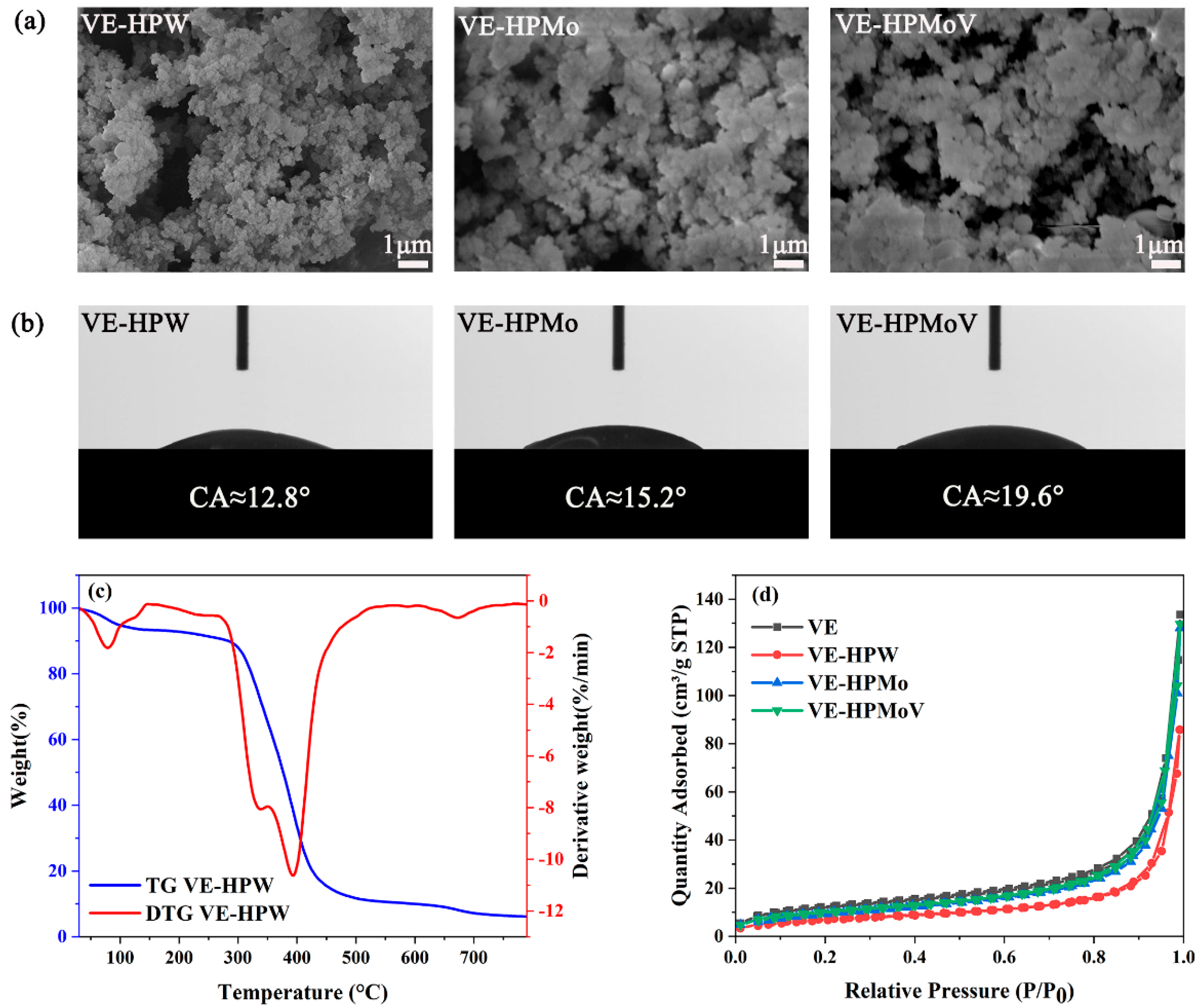
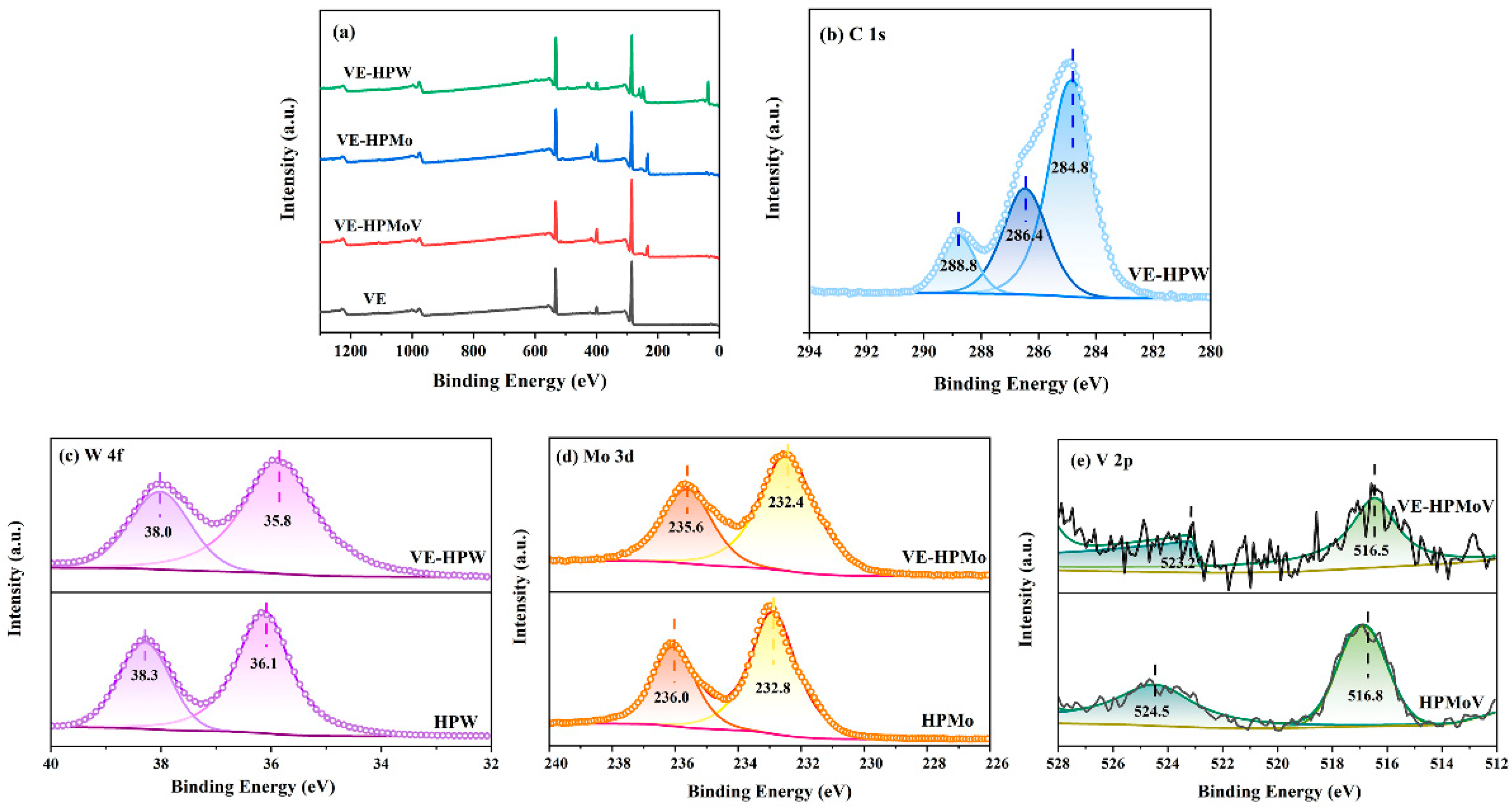
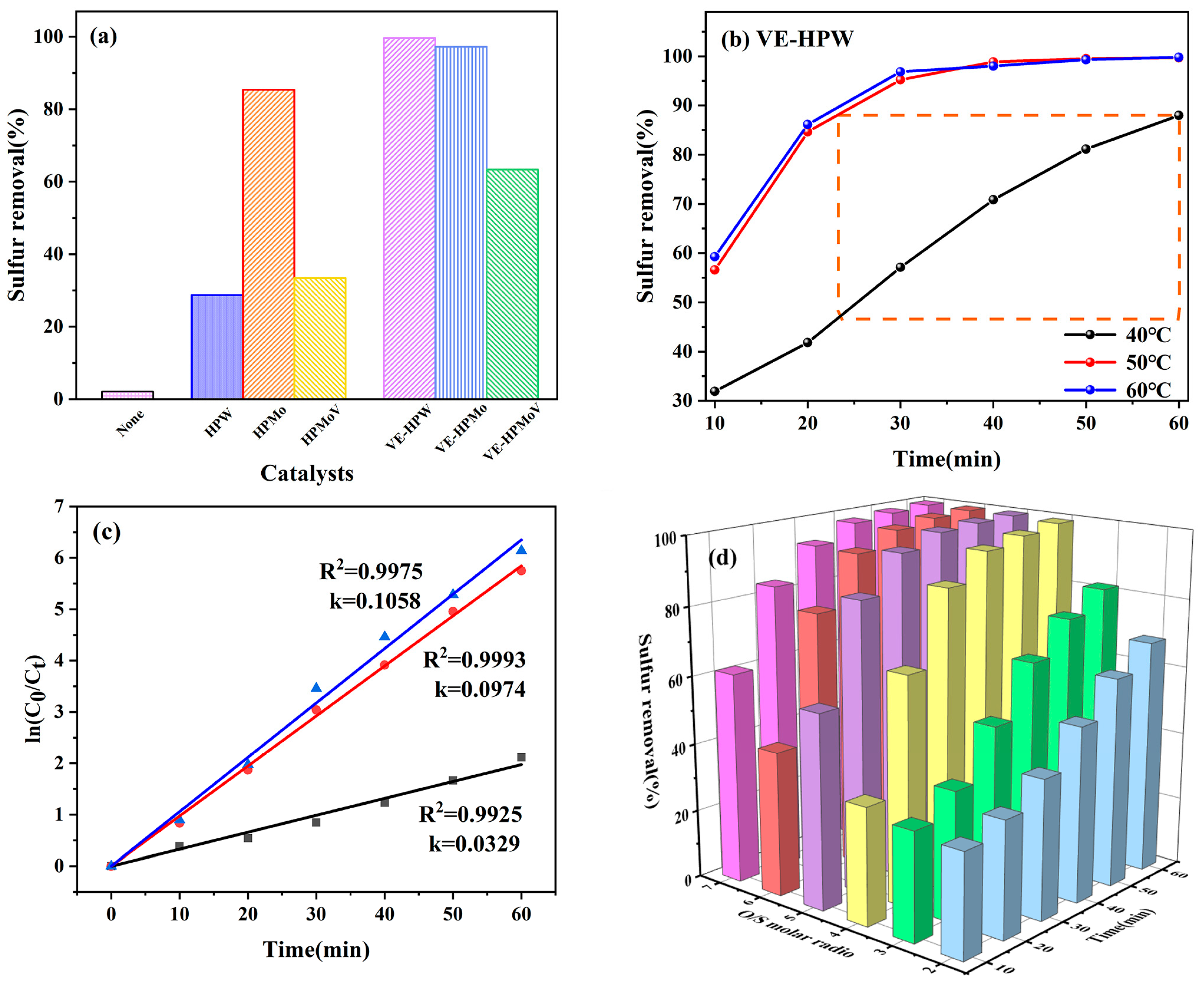

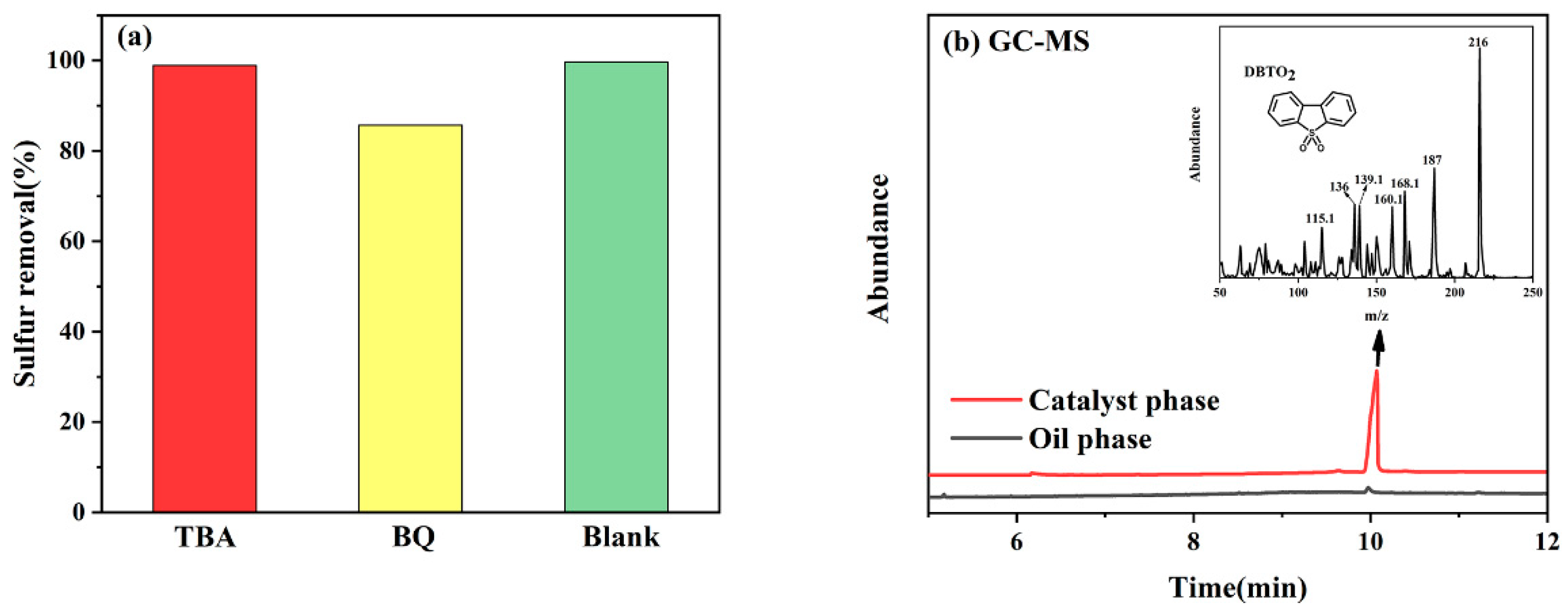

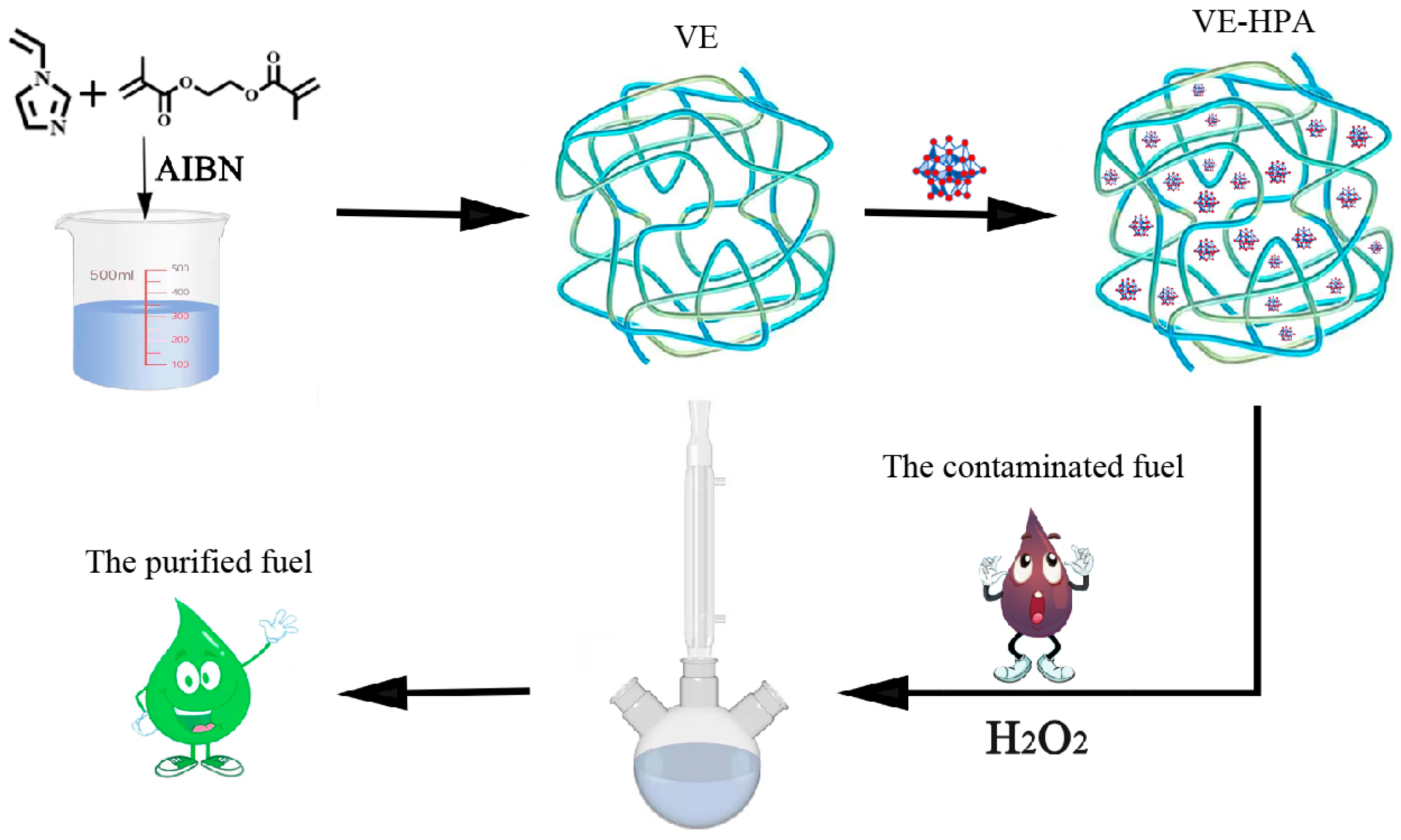
| Entry | Samples | Specific Surface Area (m2/g) | Pore Volume (cm3/g) | Pore Size (nm) |
|---|---|---|---|---|
| 1 | VE | 43.67 | 0.087 | 21.33 |
| 2 | VE-HPW | 26.24 | 0.053 | 22.69 |
| 3 | VE-HPMo | 37.52 | 0.079 | 23.02 |
| 4 | VE-HPMoV | 37.86 | 0.084 | 22.84 |
Disclaimer/Publisher’s Note: The statements, opinions and data contained in all publications are solely those of the individual author(s) and contributor(s) and not of MDPI and/or the editor(s). MDPI and/or the editor(s) disclaim responsibility for any injury to people or property resulting from any ideas, methods, instructions or products referred to in the content. |
© 2024 by the authors. Licensee MDPI, Basel, Switzerland. This article is an open access article distributed under the terms and conditions of the Creative Commons Attribution (CC BY) license (https://creativecommons.org/licenses/by/4.0/).
Share and Cite
Ren, Z.; Sheng, J.; Yuan, Q.; Su, Y.; Zhu, L.; Dai, C.; Zhao, H. Cross-Linked Polyvinylimidazole Complexed with Heteropolyacid Clusters for Deep Oxidative Desulfurization. Molecules 2024, 29, 4238. https://doi.org/10.3390/molecules29174238
Ren Z, Sheng J, Yuan Q, Su Y, Zhu L, Dai C, Zhao H. Cross-Linked Polyvinylimidazole Complexed with Heteropolyacid Clusters for Deep Oxidative Desulfurization. Molecules. 2024; 29(17):4238. https://doi.org/10.3390/molecules29174238
Chicago/Turabian StyleRen, Zhuoyi, Jiangfen Sheng, Qibin Yuan, Yizhen Su, Linhua Zhu, Chunyan Dai, and Honglei Zhao. 2024. "Cross-Linked Polyvinylimidazole Complexed with Heteropolyacid Clusters for Deep Oxidative Desulfurization" Molecules 29, no. 17: 4238. https://doi.org/10.3390/molecules29174238
APA StyleRen, Z., Sheng, J., Yuan, Q., Su, Y., Zhu, L., Dai, C., & Zhao, H. (2024). Cross-Linked Polyvinylimidazole Complexed with Heteropolyacid Clusters for Deep Oxidative Desulfurization. Molecules, 29(17), 4238. https://doi.org/10.3390/molecules29174238





